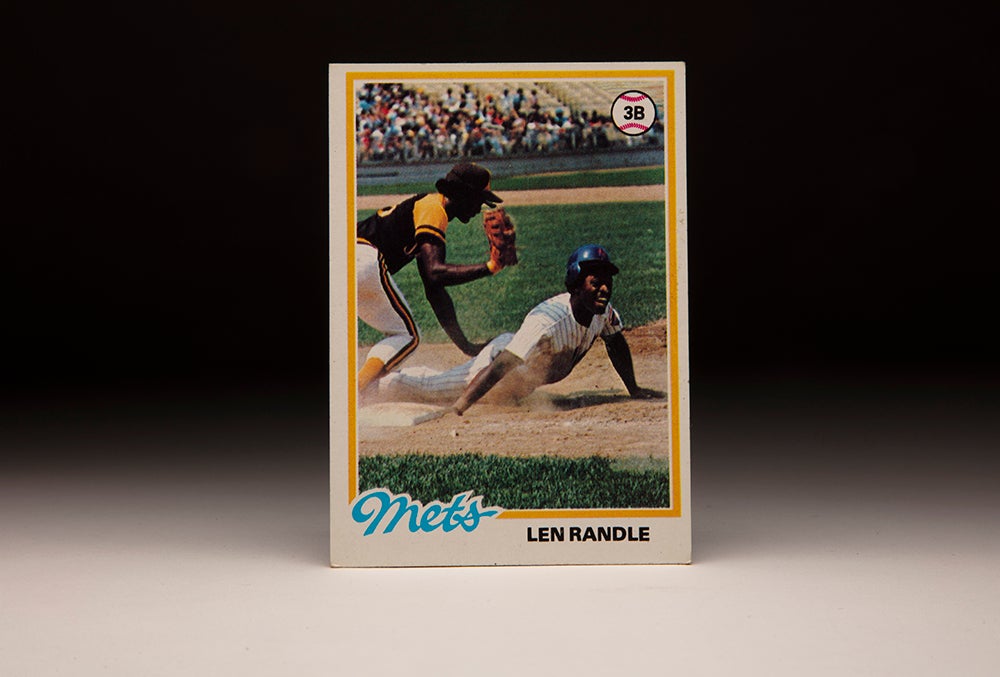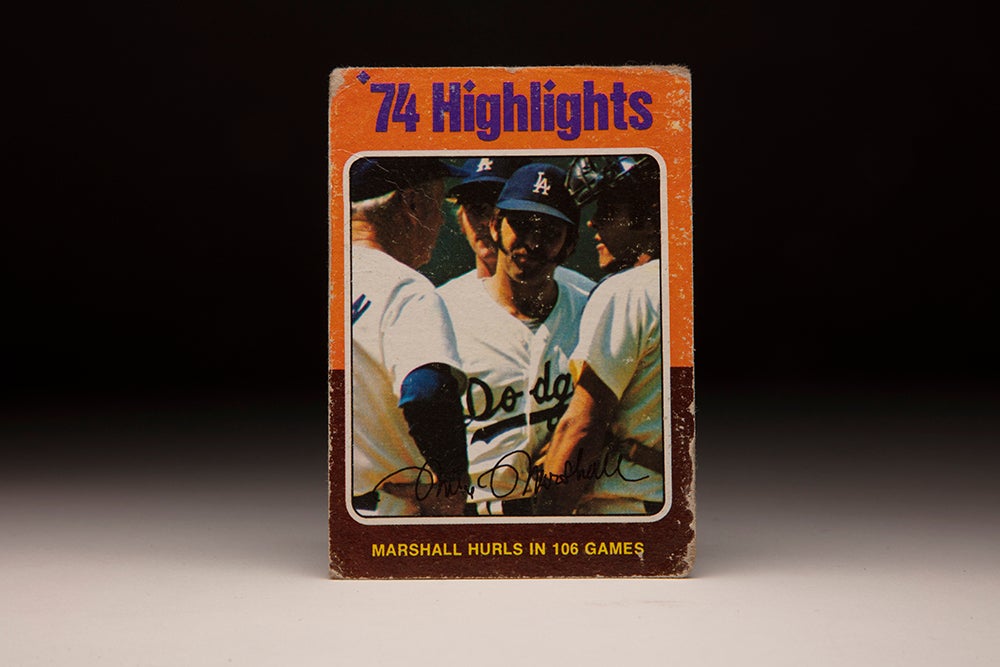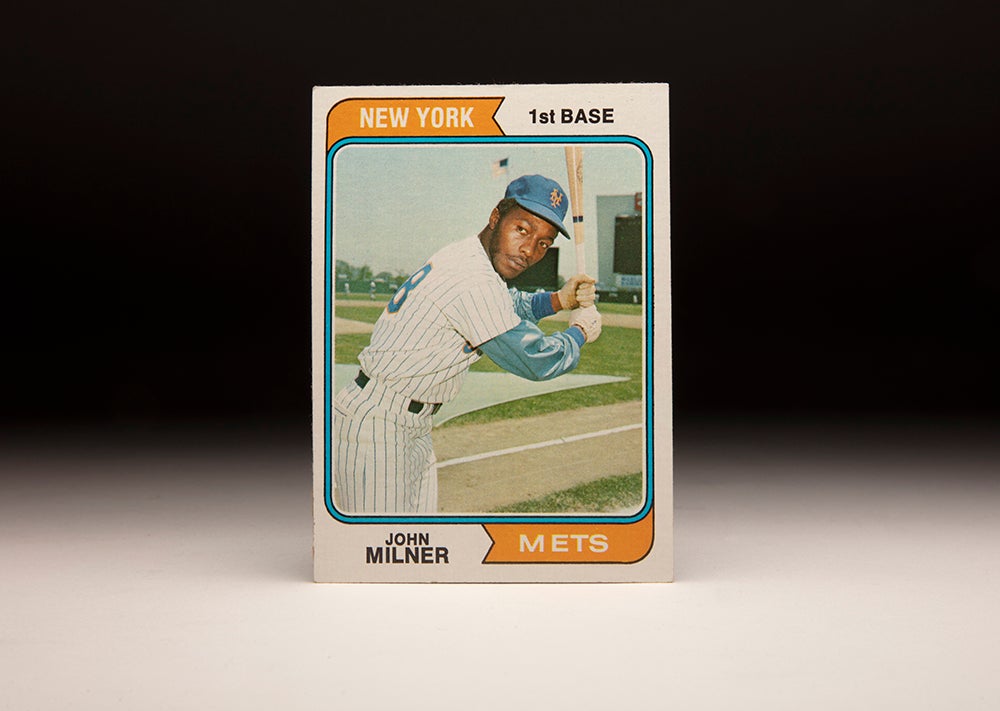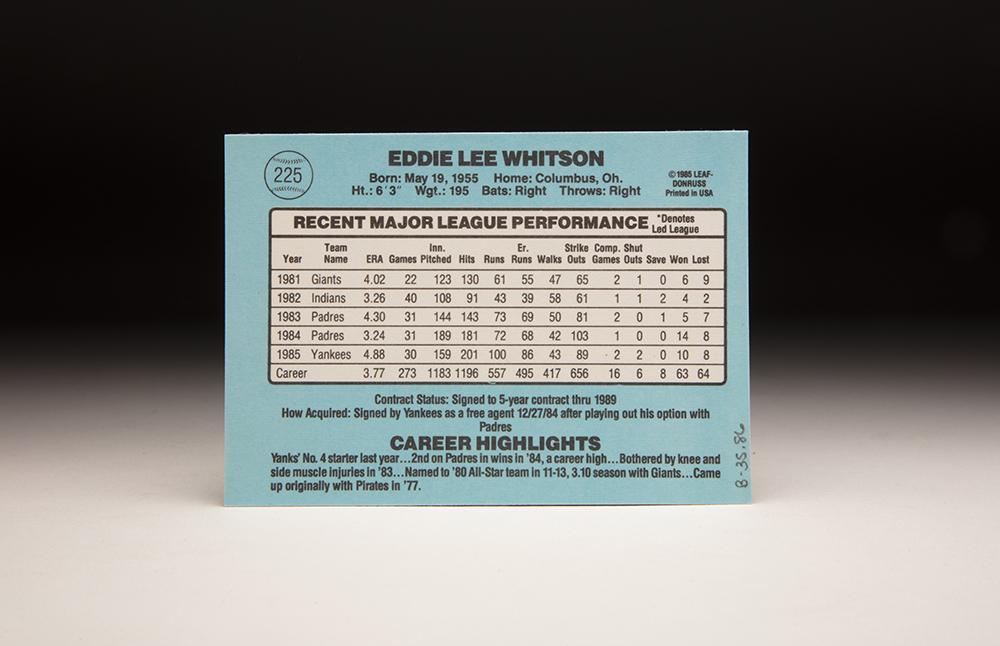- Home
- Our Stories
- #CardCorner: 1986 Donruss Ed Whitson
#CardCorner: 1986 Donruss Ed Whitson
On Sept. 22, 1985, Yankees pitcher Ed Whitson and manager Billy Martin engaged in a brawl outside a Baltimore hotel.
Martin, then in his fourth stint as Yankees manager, suffered a broken right arm and cracked ribs. He charged Whitson with fighting unfairly, using his feet maliciously in the battle. The bout made headlines across the country.
But maybe the most incredible aspect of the incident was this: Whitson was not suspended by the team and took the mound for the Yankees just 12 days later in the middle of a heated race for the AL East title.
Official Hall of Fame Merchandise
Hall of Fame Members receive 10% off and FREE standard shipping on all Hall of Fame online store purchases.
It was one of several memorable moments in a career that saw Whitson fashion a late-career resurgence that made him one of the game’s most dependable pitchers.
Born May 19, 1955, in Johnson City, Tenn., Eddie Lee Whitson starred at Unicoi County High School in nearby Erwin before being taken in the sixth round of the 1974 MLB Draft by the Pirates. He worked a handful of innings for the Pirates’ Gulf Coast League team that summer before spending the 1975 campaign with Class A Charleston of the Western Carolinas League, where he was 8-15 with a 5.07 ERA.
But in 1976, Whitson – who was growing into his 6-foot-3 frame – put himself squarely on the path to the big leagues by going 15-9 with a 2.53 ERA for Class A Salem of the Carolina League, striking out 186 batters in 203 innings.
“(Whitson) pitched good enough to be in the big leagues tonight,” Peninsula manager Cal Emery told the Daily Press of Newport News, Va., after Whitson struck out 10 of his batters without allowing an earned run over nine innings on May 7, 1976. “Few anywhere could have pitched better.”
Whitson earned an invitation to the Pirates’ Spring Training camp in 1977 before being assigned to Triple-A Columbus, where he was 8-13 with a 3.34 ERA in 26 starts before making five late-season appearances with the Pirates. He began 1978 back in Columbus and struck out 55 batters in 51 innings before earning a promotion to Pittsburgh when pitcher Bruce Kison suffered a finger injury in May.
Utilized out of the bullpen by manager Chuck Tanner, Whitson went 5-6 with four saves and a 3.28 ERA over 43 appearances and struck out 64 batters in 74 innings.
“Making the big leagues meant everything in the world to me,” Whitson told the Pittsburgh Press during Spring Training 1979. “It would tear me right down (to go back to the minor leagues). I feel I don’t have anything to prove down there.”
With three big league-ready pitches in a fastball, curveball and palm ball, Whitson made the Pirates’ Opening Day roster in 1979 but experienced bouts of inconsistent pitching as Pittsburgh got off to a slow start. Working as a spot starter and reliever, Whitson was 2-3 with one save and a 4.37 ERA in 19 games when the Pirates made a major trade – sending Whitson, Fred Breining and Al Holland to the Giants in exchange for Bill Madlock, Lenny Randle and Dave Roberts. The key to the deal was Madlock, a two-time National League batting champion who allowed the Pirates to move third baseman Phil Garner to second base while adding depth to their lineup – a move that eventually produced a World Series title for Pittsburgh.
The Giants, meanwhile, immediately inserted Whitson into the starting rotation.
“The only thing I want to do is to prove that I’m as good a pitcher as Bill Madlock is a hitter,” Whitson told the Associated Press after pitching the Giants to a 7-1 win over the Dodgers on Aug. 6, 1979. “I used the palm ball quite effectively. The palm ball looks like a slider only it’s about 45 mph slower.”
Whitson got into a clubhouse tussle with teammate Roger Metzger on Aug. 21 – though Metzger told the Associated Press that the two were “just horsing around.” It was a sign of things to come for Whitson, whose intensity would sometimes rub his teammates the wrong way.
Whitson finished the 1979 season with a combined record of 7-11 and 4.10 ERA with the Pirates and Giants. The soon-to-be 25-year-old was being counted on for regular starts for San Francisco in 1980 but started that season 0-5 and was 2-7 through June 7 – with the two wins both shutouts over the Cubs.
But Whitson won five of his next six decisions and earned a spot on the National League All-Star team when teammate Vida Blue was sidelined with an injury. It would be the only All-Star Game selection for Whitson, who finished the year 11-13 with a 3.10 ERA in 34 starts.
Another slow first half left Whitson with a 2-5 record and 4.38 ERA when the strike interrupted the 1981 season. But Whitson was more effective in the second half, sharing NL August Pitcher of the Month honors with the Braves’ Rick Camp and ending the season with a 6-9 record and 4.02 ERA.
On Nov. 14, 1981, the Giants traded Whitson to the Indians in a one-for-one swap for second baseman Duane Kuiper. But with a veteran rotation featuring Bert Blyleven, Rick Sutcliffe, Len Barker, Lary Sorensen, John Denny and Rick Waits, the Indians moved Whitson to the bullpen – and he stayed there until August when injuries, including a season-ender to Blyleven early in the year, brought him back to the rotation.
He finished the season 4-2 with a 3.26 ERA in 40 games – and wrapped up his one year in Cleveland when he was traded to the Padres for Broderick Perkins and Juan Eichelberger on Nov. 18, 1982.
“As far as I’m concerned, I never had a chance with the Indians,” Whitson told the Mansfield (Ohio) News Journal. “It was totally frustrating. Last year was a waste for both sides.”
Whitson began the 1983 season in the Padres’ rotation but suffered a left knee injury in his second start of the year on April 15 against the Dodgers. While jogging two days later, Whitson’s knee locked up and doctor’s diagnosed torn cartilage. But Whitson benefitted from new technology called “arthroscopic surgery” which allowed doctors to repair the damage without a large incision.
“I have never seen anything work so fast in my life,” Whitson told United Press International just hours after the surgery. “I can already walk on my knee right now.”
Whitson returned to action May 31 but suffered from bouts of wildness, going 5-7 with a 4.30 ERA in 31 appearances, including 21 starts. But in 1984, Whitson and the Padres put it all together – as San Diego won the National League West title and Whitson went 14-8 with a 3.24 ERA in 189 innings.
In the middle of the most successful season to that date in Padres history, however, Whitson made national news – along with the rest of the Padres and Braves – during an Aug. 12 game at Atlanta-Fulton County Stadium. The brawl that day remains one of the worst in MLB history.
Braves pitcher Pascual Pérez began the game by hitting San Diego leadoff batter Alan Wiggins in the back. The Padres, especially manager Dick Williams, believed Pérez and the Braves were retaliating after Wiggins bunted for two hits the night before in a 4-1 San Diego win that left Atlanta 10.5 games out of first place.
“My starting pitcher, Ed Whitson, one of the toughest guys in baseball…waited a couple of innings until Pérez came to the plate and then – boom! – he threw it right at Pérez’s back,” Williams wrote in his 1990 book “No More Mr. Nice Guy.” “Except Pérez knew it was coming, and he was backing away even during Whitson’s windup. So Whitson missed.”
After both teams were warned by the umpires that subsequent brushback pitches would result in ejections, Whitson threw at Pérez again and missed again – earning an ejection. But the fireworks were far from over as Padres pitcher continued to try to hit Pérez throughout the game. In the eighth inning, Craig Lefferts succeeded – sparking a brawl. Then in the ninth, Braves pitcher Donnie Moore hit San Diego’s Graig Nettles, igniting another fight that saw Whitson – wearing only his baseball pants – come out of the clubhouse and get into a spat with fans in the stands, pointing and yelling several times.
Whitson was one of nine Padres players fined, and Williams was suspended for 10 games and fined $10,000 for allegedly ordering Whitson to throw at Pérez.
Whitson saw his first career postseason action in Game 3 of the NLCS vs. the Cubs. With the Padres down 0-2 and one game away from elimination, Whitson allowed just five hits and one run over eight innings to propel San Diego to a 7-1 win. The Padres would win the NLCS in five games.
But in the World Series, Whitson fell in line with a curious San Diego trend that saw only one Padres starter – Mark Thurmond in Game 1 – work more than 2.2 innings. Whitson allowed three runs in two-thirds of an inning in his Game 2 start and did not pitch again as Detroit defeated San Diego in five games.
Whitson’s performance throughout the 1984 season, however, was good enough to make him a sought-after free agent that winter. On Dec. 27, 1984, Whitson signed a five-year deal worth $4.4 million with the Yankees.
“The No. 1 thing was the security of my family,” Whitson told the Associated Press. “Baseball is second. It’s a game. It’s something I enjoy doing.
“I want to be known as one of the leaders of the staff.”
But with a 53-56 career record at that point, Whitson became for some the embodiment of overspending in baseball as well as the target of Yankee boo birds. In 1985, Whitson went 10-8 with a 4.88 ERA and never seemed to get comfortable in his new surroundings.
The Martin vs. Whitson fight on Sept. 22, 1985, began when Martin allegedly tried to serve as a peacemaker between Whitson and a fan during an early-morning altercation in Baltimore. The media speculated that Whitson was upset that Martin had skipped him in the rotation that weekend against the Orioles. But Martin contended after the incident that Whitson was still going to take his regular turn down the stretch.
“If (Whitson) can help us win a pennant, he’s pitching,” Martin told the Associated Press.
True to his word, Martin handed Whitson the ball on Oct. 4 in Toronto, with New York needing to sweep the series to stay alive. Whitson allowed just two unearned runs in 4.2 innings and was not involved in the decision in a 4-3 Yankees win. But the Blue Jays won the following day to end New York’s season.
Martin, meanwhile, was replaced by Lou Piniella, who decided to pitch Whitson on the road as often as possible in 1986 to avoid Whitson being harassed by his home fans. The strategy proved no solution for Whitson, however, and the Yankees dealt him back to San Diego in exchange for Tim Stoddard on July 9, 1986. The campaign was a lost one for Whitson, who finished 6-9 with a 6.23 ERA over 112.2 innings for San Diego and New York.
Whitson got regular work in the Padres’ rotation in 1987 but – like many of his teammates – had a rough season, going 10-13 with a 4.73 ERA and surrendering a NL-high 36 home runs as San Diego went 65-97. But Whitson did work 205.2 innings – his most since 1980 – and struck out a career-best 135 batters.
In 1988, Whitson cut his ERA by almost a full run to 3.77 while going 13-11 in 205.1 innings. And with his reliable palm ball offsetting declining velocity, Whitson won a career-high 16 games in 1989 while posting a 2.66 ERA in 227 innings.
“If you’re not comfortable, if you’re not really 100 percent mentally and physically between the white lines, you’re not going to play up to your ability,” Whitson told Gannett News Service.
In 1990, Whitson continued to defy time and posted what may have been his best season at age 35. He went 14-9 with a 2.60 ERA, setting career-highs in shutouts (3) and innings pitched (228.2). He even hit his first big league home run while pitching a seven-hit shutout against the defending NL East champion Cubs on April 25.
Whitson earned his second career Opening Day start in 1991 (the first came in 1988) but battled elbow issues and eventually underwent surgery to remove bone spurs in July. He appeared in only three games after May 26, including a relief outing on Sept. 29 when he allowed five hits and three runs while recording one out against the Reds while trying to demonstrate that his arm was sound.
“I want to prove to other clubs my arm is healthy,” Whitson told the Escondido Times-Advocate, “that I’m not running my (tail) out there every day for nothing.”
The Padres brought Whitson back for the 1992 season but he suffered another elbow injury in Spring Training and was lost for the season. On Oct. 28, 1992, Whitson announced his retirement.
“I love pitching, and if there was any way I could, I would,” Whitson told the Associated Press. “But doctors said I risked permanent damage to my arm if I tried to pitch again. That made the decision to retire somewhat easier.”
Over 15 big league seasons, Whitson was 126-123 with a 3.79 ERA. He became a walking advertisement for perseverance during his final years with the Padres, when he seemed to get better with every season deep into his 30s.
But for Whitson, just being in the big leagues was enough for the country boy from Tennessee.
“Every man has a goal, and (making the big leagues) was always mine,” Whitson said in 1979. “In the big leagues, you are really able to enjoy the good life.”
Craig Muder is the director of communications for the National Baseball Hall of Fame and Museum
Related Stories

#CardCorner: 1986 Fleer Al Holland

#CardCorner: 1978 Topps Lenny Randle

#CardCorner: 1975 Topps Mike Marshall

#CardCorner: 1974 Topps John Milner

#CardCorner: 1986 Fleer Al Holland

#CardCorner: 1978 Topps Lenny Randle

#CardCorner: 1975 Topps Mike Marshall






